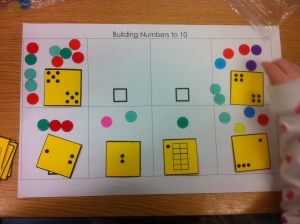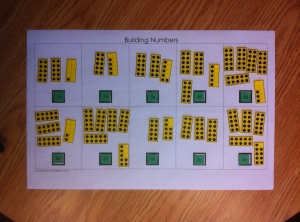I visited Mrs. Merrill’s kindergarten class today. The focus of the math lesson was on building numbers to 10, we did this with a large organizing sheet (11” x 17”), some small dot cards (each student had a set of cards 1 to 10 — download below), and small bingo chips. Students were asked to place a dot card over each square on the paper, and then use the bingo chips to make another set the same size in each box.
Some students chose to lay their cards out in rank order, while others were happy to just lay the cards in any order they pulled the card out the small bag. We also noticed some students organizing and building left to right in the boxes, while others built randomly on the page.
The organizing sheet is very “generic” on purpose allowing it to be used in a variety of ways. The number for building can be generated by a dot card, by rolling a die (or dice), by placing a number word card (e.g., “two”) over the square, by dropping a bean onto a 100 chart, etc. Students can build the number with counters, with little ten frames (I find children love to work with tiny things!), with base-10 blocks, etc.
I have not figured out how to put a large 11 x 17 paper into Dropbox, but if you will print out the template you want onto legal-sized paper, you can then enlarge at a copier 121% and it will fit the 11 x 17 page rather nicely.
I have created templates for building 8 different numbers as well as for building 10 different numbers. The latter could be used for 100 Day activities by building 10 in each space for a total of 100.
Dot cards can be downloaded here as well.
I hope you are able to use the activity in one of its “versions” in your classroom!
Mathematically yours,
Carollee



